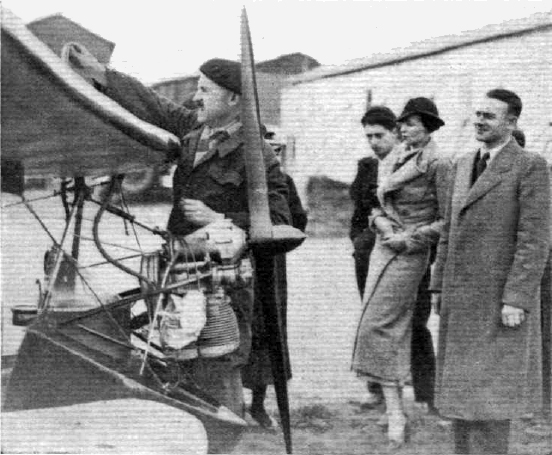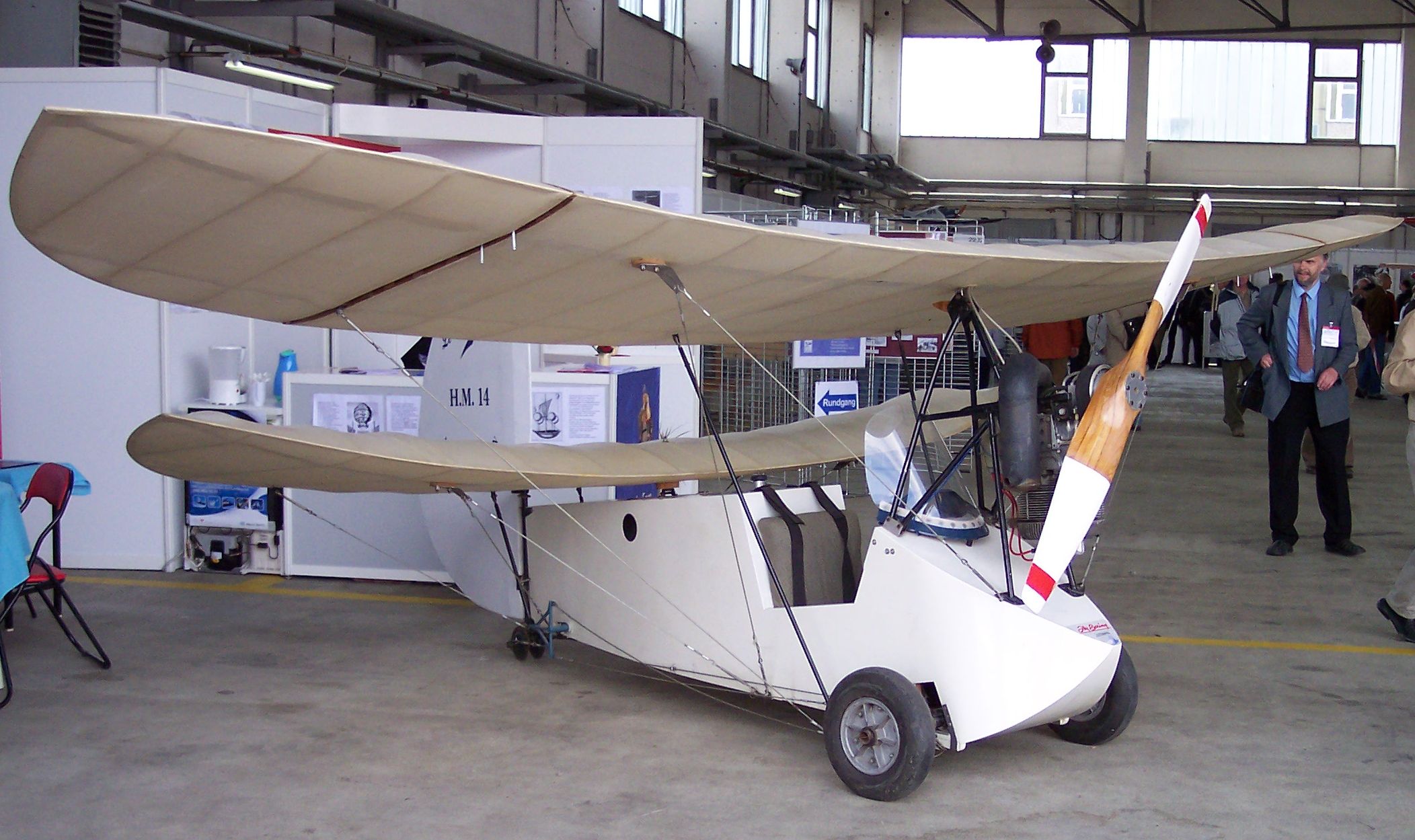Henri Mignet on:
[Wikipedia]
[Google]
[Amazon]
 Henri Mignet, (October 19, 1893 – August 31, 1965), was a French radio engineer who became well known as an
Henri Mignet, (October 19, 1893 – August 31, 1965), was a French radio engineer who became well known as an
 In March 1928, Mignet wrote an article in the magazine ''Les Ailes'' ("Wings" in English), describing his HM.8 ''Avionnette''. It was a parasol monoplane that he built in 1928 using parts from his HM.6, including a modified 10 hp Anzani engine. In 1929, the first amateur-built HM.8s made their maiden flights. In 1931, he published a book, ''Comment j'ai Construit mon Avionnette'' (''How I built my Avionnette''), containing the plans for the HM.8. Mignet encouraged amateurs to build HM.8s while he continued his research towards a new concept that became the "Pou du Ciel". About 200 HM.8s were built, with various engines, including 17 hp (13 kW) 540 cc Aubier et Dunne, 500 cc Chaise, 24 hp Harley-Davidson, 35 hp ABC Scorpion, 40 hp Salmson. Some of those directly drove the propeller, others employed a chain drive.
In March 1928, Mignet wrote an article in the magazine ''Les Ailes'' ("Wings" in English), describing his HM.8 ''Avionnette''. It was a parasol monoplane that he built in 1928 using parts from his HM.6, including a modified 10 hp Anzani engine. In 1929, the first amateur-built HM.8s made their maiden flights. In 1931, he published a book, ''Comment j'ai Construit mon Avionnette'' (''How I built my Avionnette''), containing the plans for the HM.8. Mignet encouraged amateurs to build HM.8s while he continued his research towards a new concept that became the "Pou du Ciel". About 200 HM.8s were built, with various engines, including 17 hp (13 kW) 540 cc Aubier et Dunne, 500 cc Chaise, 24 hp Harley-Davidson, 35 hp ABC Scorpion, 40 hp Salmson. Some of those directly drove the propeller, others employed a chain drive.
 On 10 September 1933, Mignet made his maiden flight in the HM.14, the first of his
On 10 September 1933, Mignet made his maiden flight in the HM.14, the first of his
 Henri Mignet, (October 19, 1893 – August 31, 1965), was a French radio engineer who became well known as an
Henri Mignet, (October 19, 1893 – August 31, 1965), was a French radio engineer who became well known as an aircraft
An aircraft is a vehicle that is able to fly by gaining support from the air. It counters the force of gravity by using either static lift or by using the dynamic lift of an airfoil, or in a few cases the downward thrust from jet engines ...
designer and builder.Ellis & Jones (1990)Plane and Pilot: ''1978 Aircraft Directory'', page 142. Werner & Werner Corp, Santa Monica CA, 1977. His most famous design is the ''Flying Flea
The Flying Flea (french: Pou du Ciel, lit=Louse of the Sky) is a large family of light homebuilt aircraft first flown in 1933.
The odd name comes from the French nickname for the Ford Model T automobile: ''Pou de la Route'', or "Louse of the Ro ...
'' family of aircraft.
Early interest in aviation
Mignet was born inCharente-Maritime
Charente-Maritime () is a department in the Nouvelle-Aquitaine region on the southwestern coast of France. Named after the river Charente, its prefecture is La Rochelle. As of 2019, it had a population of 651,358 with an area of 6,864 square kil ...
. In 1911, when he was 18 years old, he started corresponding with Gustav Lilienthal (the brother of Otto Lilienthal
Karl Wilhelm Otto Lilienthal (23 May 1848 – 10 August 1896) was a German pioneer of aviation who became known as the "flying man". He was the first person to make well-documented, repeated, successful flights with gliders, therefore making ...
) about aviation. In 1912, he built his first aircraft, the HM.1-1 model. It was a monoplane
A monoplane is a fixed-wing aircraft configuration with a single mainplane, in contrast to a biplane or other types of multiplanes, which have multiple planes.
A monoplane has inherently the highest efficiency and lowest drag of any wing confi ...
inspired by the creations of Otto Lilienthal
Karl Wilhelm Otto Lilienthal (23 May 1848 – 10 August 1896) was a German pioneer of aviation who became known as the "flying man". He was the first person to make well-documented, repeated, successful flights with gliders, therefore making ...
.
Service in the First World War
Between 1914 and 1918, Mignet served in the French army. He was a radio operator duringWorld War I
World War I (28 July 1914 11 November 1918), often abbreviated as WWI, was one of the deadliest global conflicts in history. Belligerents included much of Europe, the Russian Empire, the United States, and the Ottoman Empire, with fightin ...
. In 1918, he was hospitalized with malaria
Malaria is a mosquito-borne infectious disease that affects humans and other animals. Malaria causes symptoms that typically include fever, tiredness, vomiting, and headaches. In severe cases, it can cause jaundice, seizures, coma, or death. S ...
.
Post World War I designs
In 1920, Mignet finished his first powered aircraft prototype, the HM.2. This bore many similarities to, and took inspiration from, the designs ofLouis Blériot
Louis Charles Joseph Blériot ( , also , ; 1 July 1872 – 1 August 1936) was a French aviator, inventor, and engineer. He developed the first practical headlamp for cars and established a profitable business manufacturing them, using much of th ...
Later in describing this aircraft he said, "All the components worked, but not together..."
In 1922, he constructed the HM.3 ''"The Dromedary"'', the HM.4 parasol
An umbrella or parasol is a folding canopy supported by wooden or metal ribs that is usually mounted on a wooden, metal, or plastic pole. It is designed to protect a person against rain or sunlight. The term ''umbrella'' is traditionally used ...
, and airplane with no rudder and an Anzani 10
The Anzani 10 was a 1913 10-cylinder air-cooled radial aircraft engine. It powered several experimental aircraft and also the later production versions of the Caudron G.3 reconnaissance aircraft, the Caudron G.4 bomber/trainer and the first pr ...
CV engine, and the HM.5, a sailplane
A glider or sailplane is a type of glider aircraft used in the leisure activity and sport of gliding (also called soaring). This unpowered aircraft can use naturally occurring currents of rising air in the atmosphere to gain altitude. Sailplan ...
. In 1924, he sold the HM.5 sailplane for a large sum of money.
In 1925, he was forced to start raising chickens to finance the development of his HM.6 project, a pusher propeller aircraft, and a helicopter
A helicopter is a type of rotorcraft in which lift and thrust are supplied by horizontally spinning rotors. This allows the helicopter to take off and land vertically, to hover, and to fly forward, backward and laterally. These attributes ...
, designated the HM.7.
In 1926, Mignet married Annette Triou, who was later murdered by Communist gunmen in 1944.
The HM.8 Avionnette
 In March 1928, Mignet wrote an article in the magazine ''Les Ailes'' ("Wings" in English), describing his HM.8 ''Avionnette''. It was a parasol monoplane that he built in 1928 using parts from his HM.6, including a modified 10 hp Anzani engine. In 1929, the first amateur-built HM.8s made their maiden flights. In 1931, he published a book, ''Comment j'ai Construit mon Avionnette'' (''How I built my Avionnette''), containing the plans for the HM.8. Mignet encouraged amateurs to build HM.8s while he continued his research towards a new concept that became the "Pou du Ciel". About 200 HM.8s were built, with various engines, including 17 hp (13 kW) 540 cc Aubier et Dunne, 500 cc Chaise, 24 hp Harley-Davidson, 35 hp ABC Scorpion, 40 hp Salmson. Some of those directly drove the propeller, others employed a chain drive.
In March 1928, Mignet wrote an article in the magazine ''Les Ailes'' ("Wings" in English), describing his HM.8 ''Avionnette''. It was a parasol monoplane that he built in 1928 using parts from his HM.6, including a modified 10 hp Anzani engine. In 1929, the first amateur-built HM.8s made their maiden flights. In 1931, he published a book, ''Comment j'ai Construit mon Avionnette'' (''How I built my Avionnette''), containing the plans for the HM.8. Mignet encouraged amateurs to build HM.8s while he continued his research towards a new concept that became the "Pou du Ciel". About 200 HM.8s were built, with various engines, including 17 hp (13 kW) 540 cc Aubier et Dunne, 500 cc Chaise, 24 hp Harley-Davidson, 35 hp ABC Scorpion, 40 hp Salmson. Some of those directly drove the propeller, others employed a chain drive.
The HM.14 Pou du Ciel
 On 10 September 1933, Mignet made his maiden flight in the HM.14, the first of his
On 10 September 1933, Mignet made his maiden flight in the HM.14, the first of his Mignet Pou-du-Ciel
The Flying Flea (french: Pou du Ciel, lit=Louse of the Sky) is a large family of light homebuilt aircraft first flown in 1933.
The odd name comes from the French nickname for the Ford Model T automobile: ''Pou de la Route'', or "Louse of the Ro ...
(Flying Flea) designs. In 1934, he published ''Le Sport de l'Air'' and playfully called the aircraft ''Pou du Ciel'' (literally "Louse of the Sky" in French) with the intention that it would be built by amateurs
An amateur () is generally considered a person who pursues an avocation independent from their source of income. Amateurs and their pursuits are also described as popular, informal, self-taught, user-generated, DIY, and hobbyist.
History
...
.Bowers (1984)
In 1936, after a number of fatal accidents, the HM.14 was tested in wind tunnels in France and in England, and a design fault was identified and corrected. The Flying Flea subsequently became a great, if controversial, success in the aviation world. The fatal accidents due to the initial, flawed, design meant that professional aircraft manufacturers were very reluctant to produce versions of the Pou.
Mignet encouraged amateur-builders to construct the HM.14, but he also carried on designing further models into the 1960s, all of them based on the Flying Flea concept.
Mignet died, aged 71, in Pessac
Pessac (; ) is a commune in the Gironde department in Nouvelle-Aquitaine in southwestern France. It is a member of the metropolis of Bordeaux, being the second-largest suburb of Bordeaux and located just southwest of it. Pessac is also home to B ...
in Gironde.
References
Bibliography
*Bowers, Peter M. 1984. ''Guide to Homebuilts - Ninth Edition'', Chapter 7 Shattered Dreams, pages 73–78. TAB Books *Ellis, Ken; Jones, Geoff. 1990. ''Henri Mignet and his Flying Fleas''. Haynes PublishingExternal links
* * {{DEFAULTSORT:Mignet, Henri People from Saintes, Charente-Maritime 1893 births 1965 deaths French aviators French aerospace engineers